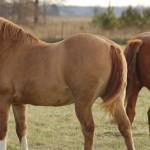Is Your Horse Going Bald?

Although horses almost never lose all their hair, even in cases of starvation, they do develop small hairless areas from time to time. These bare spots may be the result of injuries like bites and kicks that have scraped off a section of hair without breaking the skin. They can also be caused by ringworm, rain rot, and other bacterial or fungal infections. These conditions can usually be treated with the application of topical medications, though they can be slow and stubborn to clear up.
Another cause of hair loss is equine alopecia areata. This condition involves inflammatory changes in and around the hair follicle. It is fairly rare, with one study identifying only 15 cases in a review of more than 30 years of the treatment records kept by several veterinarians. It is somewhat more common in adult Appaloosas and Quarter Horses and has the most obvious effect in mane, tail, and facial hair during spring and summer months. The pattern of hair loss may come and go, and can sometimes resolve completely without treatment.
Owners who find patchy hair loss on their horses should call a veterinarian for diagnosis and treatment, and should avoid sharing tack and grooming equipment between the infected horse and horses with normal coats.
A complete and balanced diet ensures that the horse has the necessary nutrients to maintain proper hair growth. Use of a nutritional hoof and coat supplement will support growth of new hair after an infection clears up and will make any coat shinier. Kentucky Equine Research recommends the use of Bio-Bloom PS (Bio-Bloom HF in Australia), a dual-action supplement designed to promote and maintain healthy hooves and skin from the inside out. Unfortunately, there’s no way to speed up coat growth, though bare spots tend to fill in rapidly once injuries and infections heal.








